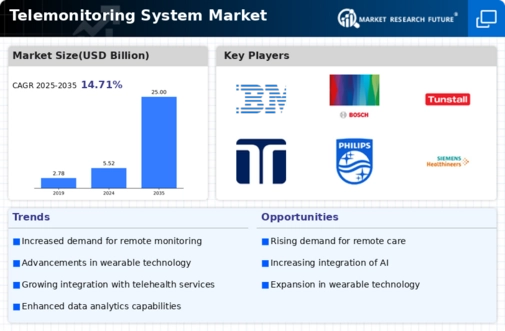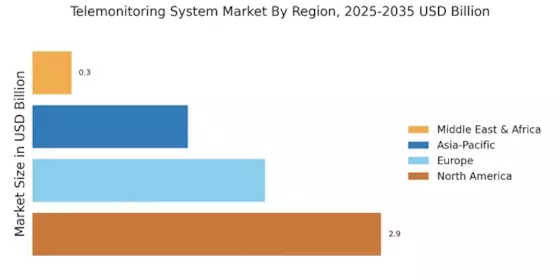Growing Aging Population
The growing aging population is a significant driver of the Telemonitoring System Market. As individuals age, they often experience multiple health issues that require ongoing monitoring and management. The World Health Organization projects that the number of people aged 60 years and older will double by 2050, creating a substantial demand for telemonitoring solutions. Telemonitoring systems provide a practical means for elderly patients to receive care from the comfort of their homes, reducing the need for frequent hospital visits. This not only enhances the quality of life for older adults but also alleviates pressure on healthcare systems. Consequently, the Telemonitoring System Market is likely to expand as healthcare providers seek to address the unique needs of this demographic, ensuring that they receive timely and effective care.
Increased Focus on Preventive Healthcare
The Telemonitoring System Market is benefiting from an increased focus on preventive healthcare strategies. Healthcare systems are shifting from reactive to proactive approaches, emphasizing the importance of early detection and management of health issues. Telemonitoring systems play a crucial role in this paradigm shift by enabling continuous health monitoring and timely interventions. Data indicates that preventive healthcare can reduce overall healthcare costs by up to 30%, making it an attractive option for both providers and patients. By leveraging telemonitoring technologies, healthcare organizations can identify potential health risks before they escalate, thereby improving patient outcomes and reducing the burden on healthcare facilities. This growing emphasis on preventive care is likely to drive the expansion of the Telemonitoring System Market, as stakeholders seek innovative solutions to enhance population health.
Technological Advancements in Telehealth
Technological advancements are significantly shaping the Telemonitoring System Market, enhancing the capabilities and functionalities of telehealth solutions. Innovations such as wearable devices, mobile health applications, and cloud-based platforms are facilitating seamless data transmission and real-time monitoring. For instance, the integration of Internet of Things (IoT) technology allows for the collection of vast amounts of health data, which can be analyzed to provide actionable insights. This evolution in technology not only improves the accuracy of health assessments but also fosters patient engagement and adherence to treatment plans. As healthcare providers increasingly adopt these advanced technologies, the Telemonitoring System Market is likely to witness accelerated growth, driven by the demand for more efficient and effective healthcare delivery models.
Supportive Government Policies and Funding
Supportive government policies and funding initiatives are emerging as key drivers in the Telemonitoring System Market. Governments are increasingly recognizing the value of telehealth solutions in improving healthcare access and efficiency. Various funding programs and incentives are being introduced to encourage the adoption of telemonitoring technologies among healthcare providers. For example, reimbursement policies for telehealth services are being expanded, allowing providers to receive compensation for remote monitoring activities. This financial support not only incentivizes healthcare organizations to invest in telemonitoring systems but also enhances patient access to essential health services. As these supportive measures continue to evolve, the Telemonitoring System Market is expected to experience robust growth, driven by increased adoption rates and improved healthcare delivery.
Rising Demand for Remote Patient Monitoring
The Telemonitoring System Market is experiencing a notable increase in demand for remote patient monitoring solutions. This trend is largely driven by the growing prevalence of chronic diseases, which necessitate continuous monitoring and management. According to recent data, approximately 60% of adults have at least one chronic condition, leading to a heightened need for effective telemonitoring systems. These systems enable healthcare providers to track patients' health metrics in real-time, thereby improving patient outcomes and reducing hospital readmissions. Furthermore, the convenience of remote monitoring appeals to both patients and healthcare professionals, as it allows for timely interventions and personalized care plans. As the population ages and the burden of chronic diseases escalates, the Telemonitoring System Market is poised for substantial growth, reflecting a shift towards more proactive healthcare management.


















Leave a Comment